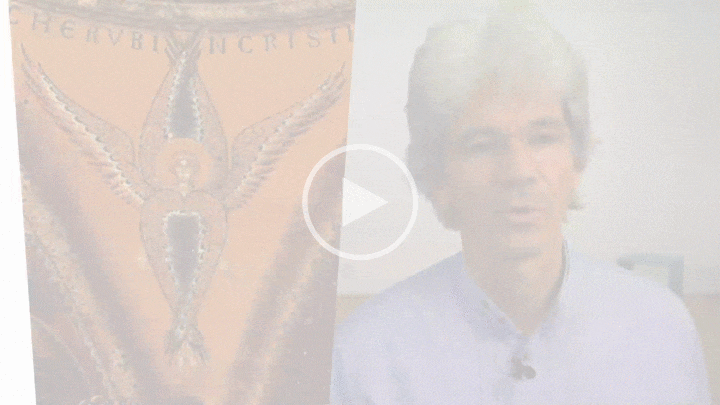Rudolf Steiner: The Musical Hallelujah
The musical is able to present the Christ impulse in tones, in formed tones, in soulful, in spiritual tones once before the world. If the music is inspired by anthroposophical spiritual science, it will find the way to it, because it will unravel in a purely artistic, artistic, emotional way how that which lives in the cosmic-telluric as the Christ impulse can be symphonically enlivened in tones.
To do this, one only needs to be able to deepen the area of thirds in the major in an inwardly deepening of the musical experience that goes deep into the mystical. If you experience this as something that is musically resolved entirely within the human being, and if one then feels the area of fifths in major, one experiences the area of fifths as that which has something enveloping, which benefits from that when the person is in the formation of the fifth grows into it, it reaches the limits of the human and the cosmic, where the cosmic sounds into the human, the human longs out into the cosmic, indeed storms out, then one can precisely in the musical through the mystery that between the thirds and the Regions of fifths in major play out something of that which, as an inner human, wants to go out into the cosmic. And then one arrives at first allowing life in the cosmos to emerge in the seventh dissonances, where the seventh dissonances speak as that which a person can experience in the cosmos when he is on the way out into the different regions of the mind, and one arrives to let the seventh dissonances vanish in such a way that they take on something specific through their vanishing, then the seventh dissonances finally get something in the vanishing, which presents itself as a musical firmament to the musical experience.
And if you have already hinted at a minor experience in intimate features in the major experience, you then find in this blurring of the seventh dissonances, in this self-shaping of the seventh dissonances into a totality that is almost harmonious in its totality becomes, almost consonant, because it disappears, one finds in it the possibility to get out in an intense minor § out of the seventh dissonance, from the almost harmonic of the dissonance of the seventh dissonances, one finds the way back to the fifth domain in minor and from there the assertion of the fifth domain with the minor thirds, then one has in this way produced the experience, the musical experience of the incarnation, specifically the incarnation of Christ.
Because you will be able to find yourself in this feeling out into the seventh area, which only apparently dissonates towards the cosmic feeling, which you shape into a firmament by having the octave as behind it, but only approximately behind it, you have grasped this in feeling, If one then returns in the manner indicated and finds, how in the germ form of the third consonances in minor there is the possibility to represent the incarnation like something musical, then if one goes back again to the major in this area, there is the "Hallelujah" of Christ to sound out of this musical design, purely musically, purely out of the design of the tones. Then the person will conjure up something directly supersensible within the shaping of the tones in this shaping of the tones, and present it for the musical sensation.
The Christ impulse can be found in the musical.
Rudolf Steiner, The Initiate Consciousness, 11th lecture on August 22, 1924 in Torquay
Translation Adele Waldmann, Eurythmy4you, June 2021
German original version
German original version:
Das Musikalische ist befähigt, den Christus-Impuls in Tönen, in gestalteten Tönen, in durchseelten, in durchgeistigten Tönen einmal vor die Welt hinzustellen. Lässt sich die Musik inspirieren von anthroposophischer Geisteswissenschaft, wird sie die Wege dazu finden, denn sie wird rein künstlerisch, artistisch, gefühlsmässig enträtseln, wie in Tönen symphonisch belebt werden kann dasjenige, was im Kosmisch-Tellurischen als der Christus-Impuls lebt.
Man braucht dazu nur in einer innerlich bis ins Mystische in der Empfindung gehenden Vertiefung des musikalischen Erlebens das Terzengebiet in Dur vertiefen zu können. Erlebt man dies als etwas, was musikalisch ganz im Inneren des Menschen beschlossen ist, und empfindet man dann das Quintengebiet in Dur, empfindet man das Quintengebiet als dasjenige, was etwas Umhüllendes hat, was etwas davon hat, dass, wenn der Mensch in die Quintengestaltung hineinwächst, er bis an die Grenze des Menschlichen und Kosmischen gelangt, wo das Kosmische in das Menschliche hereintönt, das Menschliche in das Kosmische hinaus sich sehnt, ja hinaussehnend stürmt, dann kann man gerade im Musikalischen durch das Mysterium, das zwischen dem Terzen- und Quintengebiete in Dur sich abspielt etwas erleben von dem, was als Innermenschliches in das Kosmische hinaus will. Und gelangt man dann dazu, zuerst auftönen zu lassen in den Septimendissonanzen das Leben im Kosmos, wo die Septimendissonanzen sprechen als dasjenige, was der Mensch im Kosmos empfindend erleben kann, wenn er sich auf dem Wege befindet in die verschiedenen Geistesregionen hinaus, und gelangt man dazu, die Septimendissonanzen verschweben zu lassen so, dass sie gerade durch ihr Verschweben etwas Bestimmtes annehmen, dann bekommen die Septimendissonanzen zuletzt im Verschweben etwas, was sich wie ein musikalisches Firmament dem musikalischen Erleben darstellt.
Und findet man dann, indem man vorher schon angedeutet hat in intimen Zügen ein Moll-Erleben in dem Dur-Erleben, findet man dann in diesem Verschweben der Septimendissonanzen, in diesem Sich-Gestalten der Septimendissonanzen zu einer Totalität, die in ihrer Totalität fast harmonisch wird, fast konsonierend wird, weil sie verschwebt, findet man darinnen die Möglichkeit, in intensivem Moll herauszubekommen§ aus der Septimendissonanz, aus dem fast Harmonischen des Verschwebens der Septimendissonanzen, findet man zurück den Weg ins Quintengebiet in Moll und von da das Durchsetzen des Quintengebietes mit dem Moll-Terzengebiet, dann hat man auf diesem Wege erzeugt das Erleben, das musikalische Erleben der Inkarnation, und zwar gerade der Inkarnation Christi.
Denn man wird finden können in diesem Sich-hinaus-Fühlen in das dem kosmischen Empfinden gegenüber nur scheinbar dissonierende Septimengebiet, das man zu einem Firmament gestaltet, indem man die Oktave wie dahinterstehend, aber nur annähernd dahinterstehend hat, hat man dieses im Erfühlen ergriffen, kehrt man dann in der angedeuteten Weise zurück und findet, wie in der Keimgestalt der Terzenkonsonanzen in Moll die Möglichkeit liegt, wie etwas Musikalisches die Inkarnation darzustellen, dann darf, wenn wiederum zurückgegangen wird zum Dur auf diesem Gebiete, da das «Halleluja» des Christus aus dieser musikalischen Gestaltung herausklingen, rein musikalisch, rein aus der Gestaltung der Töne heraus. Dann wird der Mensch innerhalb der Gestaltung der Töne herauszaubern in dieser Formung der Töne ein unmittelbar Übersinnliches, es für das musikalische Empfinden hinstellen.
Der Christus-Impuls kann im Musikalischen gefunden werden.
Rudolf Steiner, Das Initiaten-Bewusstsein, 11. Vortrag am 22. August 1924 in Torquay













